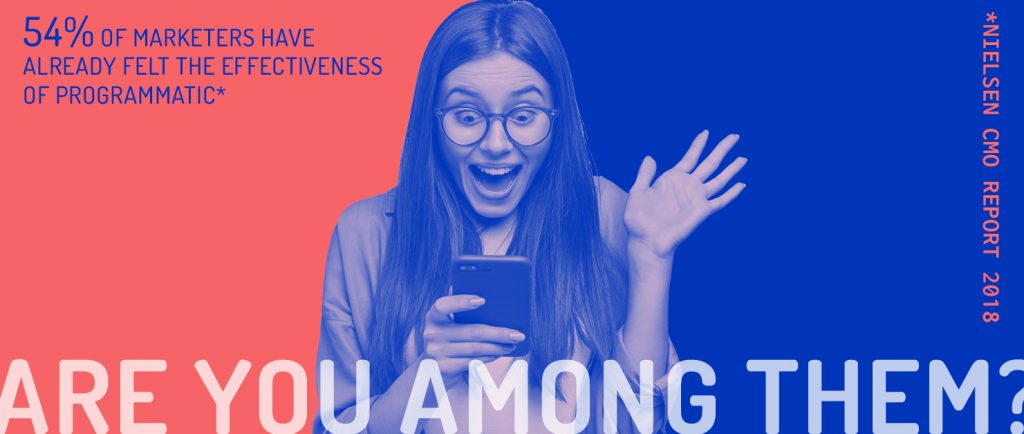Programmatic advertising is rapidly becoming the most popular trend on the market. Initially, it started out as a tool used mostly by big corporations, but has since caught on with smaller business owners as well.
According to Nielsen CMO report 2018, 54% of marketers have already felt the effectiveness of programmatic advertising, and the percentage is only going to grow. Emarketer estimates that more than four fifth of every five digital display dollars are transacted via programmatic in the US. By their predictions, 86.3% of all digital display advertising deals in the US will be programmatic by 2020 – accounting for nearly $69 billion in ad spending.
So, why is programmatic so popular and what advantages does it have over traditional advertising methods? To understand this, we need to go into detail.
WHAT IS PROGRAMMATIC ADVERTISING?
Simply put, programmatic advertising is a tool that uses software to sell and purchase ad placements. It relies on AI algorithms to deliver contextual advertisement to the user.
Programmatic encompasses two different types of media buying:
- Programmatic direct;
- RTB.
Direct programmatic advertising works just like traditional methods, but faster. Advertisers use software to purchase a number of impressions from an ad space.
RTB, or real-time bidding, works a little bit differently. It allows businesses to display their advertisement on a variety of websites to those users, and only to those users, who belong to their demographics. Besides publishers and advertisers, the process involves a supply-side platform (SSP) and a demand-side platform (DSP).
This is how it goes: first, the publisher offers ad inventory on their web pages for sale. Advertisers place bids to reach their target audience. The space is won by the highest bidder. Performed by humans, these actions would have taken days and even weeks to complete. Automated software does the same within milliseconds.
In the moment when a user starts loading the web page with an ad display, the bidding begins. Software sends user statistics to advertisers, and DSP automatically evaluates all the criteria by which this user meets their demographic requirements. The bid is made in real-time based on how likely the user is to engage with the ad.
Why Programmatic?

In a way, this switch to automated advertising has been inevitable for a while. Before, advertising deals used to require long negotiations, meetings in person, signing insertion orders, and altogether too many procedures influenced by the human factor. With the expanding of the digital sphere, the number of publishers had grown to the point where the supply of ad space far outgrew the demand. Finding the right placement for your ads became a complicated task, human negotiations too time-consuming with thousands of publishers to choose from.
The automation of all these processes was the logical way out, and it came in the form of programmatic.
There are a bunch of benefits to be gained from switching to programmatic advertising from more traditional means. Let’s explore them in more detail.
ADVANCED TARGETING OPTIONS
The range of targeting options available to clients of traditional display advertising is somewhat limited. Age, gender, location, marital status, even interests – these characteristics still don’t give marketers enough information to work with. Serving ads based on them is more or less a shot in the dark.
Programmatic advertising, on the other hand, uses contextual and behavioral techniques to collect all the marketing data about the user from all the devices they engage with. The type of websites they browse, the things they’ve purchased, the locations they visit – everything is included into the equation. This means always serving the right ad to the right customer at the right time.
GREATER ROI
The previous factor makes advertising much more effective. Less clicks are wasted, less budget is spent trying to calibrate the campaign to perfection. The potential increase in conversion from switching to programmatic advertising could be immense. Advertisers are getting larger returns on smaller investments, which is exactly what everyone aims to achieve.
FLEXIBILITY
Traditional deals mean setting the conditions in stone, and losing money if the pre-negotiated approach turns out ineffective. This is no longer a problem with programmatic advertising solutions that adjust your campaign settings on the go. And you can monitor the analytics in real-time to make manual adjustments as well.
FULL CONTROL
With precise targeting options and detailed analytics, you have all the tools to manage your ads. Monitor and optimize the campaign in real time to increase its efficiency and your ROI.
CROSS-PLATFORM CAPABILITIES
Compared to traditional ads, programmatic advertising encompasses more platforms and devices. Pre-roll videos on Youtube, email newsletters, ads included in gaming apps are used alongside more traditional inventory. Being both cross-platform and cross-device, it tracks user’s behavior and serves them tailored ads much more effectively than any traditional means.
EASE OF USE
Business owners no longer have a need to hire a special person for negotiating business deals when the middleman element is eliminated. Programmatic software does most of the work, saving advertisers valuable time and budget – and it is not overly complicated for the average user either.
So, can we expect that programmatic advertising will do away with the traditional advertising means completely? At the moment it looks like that might be an exaggeration. However, it is definitely going to dominate the field, leaving advertising professionals more time to plan complicated campaigns instead of dealing with routine tasks.
To start experiencing the benefits of programmatic for your business, visit our platform. Let’s help your project get top visibility!

